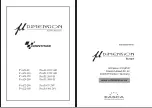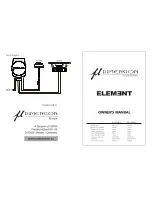
EVI-28 250-
W
att T
w
o
-W
ay Compact V
ari Intense
®
Speaker
System
EVI-28 250-Watt Two-Way Compact Vari Intense
®
Speaker System
2
responses were measured in an anechoic
environment at 20 feet using one-third-oc-
tave pink-noise inputs at 2 degree resolu-
tion (over 870,000 data points). The fre-
quencies selected are fully representative
of the polar response of the system.
Beamwidth of the system utilizing the com-
plete one-third-octave polar data is shown
in Figures 5 and 6. R
θ
and the directivity
index (D
i
) are plotted in Figure 7.
Constant Directivity and Variable
Intensity
Constant-directivity systems are specially
tuned to provide a consistent, smooth tran-
sition from the low-frequency subsystem
through the high-frequency horn’s oper-
ating range. These systems nearly always
have symmetrical vertical dispersion pat-
terns and a constant horizontal dispersion
versus elevation. When a constant-direc-
tivity system is installed above a surface,
the SPL on the floor varies significantly
from front-to-back and left-to-right. The
front-to-back variation can be minimized
by tilting the horn further back, but this
always results in a large amount of slap
echo, less dynamic range and poor intelli-
gibility as a result of excessive energy dis-
persed into the reverberant field. The so-
lution is Electro-Voice’s revolutionary
patented
1
Vari Intense
®
horn that throws
a 6- to 10-dB hotter signal to the back of
the room while providing a wide nearfield
angle and a narrow farfield angle. The vari-
able horizontal angle ensures a rectangu-
lar floor pattern, and the intensity change
compensates for the drop in SPL over
the longer distance to the back of the room
(13 feet for the short throw and 55 feet for
the long throw in a typical underbalcony
application such as Figure 7). This single
horn replaces a short-throw/long-throw
horn combination, cutting materials and
labor time while increasing performance
with higher intelligibility and more uniform
coverage. The system is provided with a
2,000-Hz passive crossover featuring
tweeter protection and a proprietary pas-
sive equalization circuit that provides fre-
quency-shading, amplitude-shading and
time delay to the two woofers. An Acous-
tic Lens Filter (ALF) on the grille helps to
eliminate spurious lobes and provides a
degree of acoustic loading. These features
heavily modify the polar response of the
two woofers, providing an extremely uni-
form polar pattern with a shape that
matches the VI horn’s unique SPL profile.
They also smooth the transition between
woofers and the horn to minimize horizon-
tal lobes, providing amazingly even cover-
age through the crossover point. This ex-
tends the VI characteristic down to 500 Hz
in an extremely compact enclosure.
Installation Tactics
The EVI-28 is designed to provide sub-
stantially even SPL over a floorplan of a
size that is determined by the height of the
system above the floor and the vertical aim-
ing angle of the system relative to the floor.
The recommended operational vertical
angle is minus 5 degrees from the top sur-
face of the enclosure to minus 45 degrees,
defining a maximum used vertical disper-
sion of 40 degrees. The standard aiming
of the system when it is mounted above a
flat floor is with the top of the enclosure
parallel to the floor. In this orientation, the
system will provide even SPL over a
floorplan that is approximately twice as
wide as the mounting height, and five times
as long. Tilting the enclosure down by
approximately 10- to 15-degrees relative to
the slope of the floor will produce a floorplan
twice as wide as the mounting height and
approximately three times the depth. At the
standard aiming, the 45-degree nearfield
operational angle defines an approximate
offset to the first useable row of one-half
the height of the speaker system above
the listening plane.
In a typical installation, the top surface of
the loudspeaker will point slightly above
the head height of the furthest targeted
seating or standing area. This will ensure
the minimum amount of slap echo from the
back wall. In an under-balcony situation,
the sharp cutoff above the zero degree axis
prevents early ceiling reflections from caus-
ing interference patterns in the listening
area. Since the EVI-28 has a very smooth
and rapid drop-off towards directly below
the cabinet, you can actually stand right in
front of the speaker (see Figure 10) with-
out ear strain or microphone feedback. The
remarkable absence of lobes to the rear al-
lows the system to be mounted directly
overhead to target a particular area with-
out disturbing the audience below or be-
hind the cabinet.
For example, Figure 9 shows a typical un-
der-balcony application that has a floor
with an upward slope of 5 degrees. The
speaker is mounted 10 feet above the
seated head height, so the horizontal width
is fixed at approximately 20 feet. The en-
closure is tilted back by 5 degrees to pro-
vide a 50-foot throw, with the outskirts of
the pattern filling in the rear aisle area with
tonally accurate but reduced overall SPL.
If the under-balcony seating area is only
35 feet deep, then the enclosure should be
tilted down by about 10 degrees relative to
the floor in order to prevent excess slap
echo and preserve intelligibility.
Figure 10 shows a typical small-room ap-
plication, perfect for a 20-foot by 30-foot
boardroom or meeting hall. In this case,
the head height is actually defined by a
standing height of approximately 6 feet, so
the long-throw axis should be very close
to vertical. Then the included 40 degree
angle points directly towards the entire lis-
tening area, minimizing slap echo while re-
taining a full width, high intelligibility and
even SPL throughout the listening area.
Power Handling
To our knowledge, Electro-Voice was the
first U.S. manufacturer to develop and pub-
lish a power test closely related to real-life
conditions. First, we use a random-noise
input signal because it contains many fre-
quencies simultaneously, just like real voice
or instrument program. Second, our signal
contains more energy at extremely high and
low frequencies than typical actual pro-
gram, adding an extra measure of reliabil-
ity. Third, the test signal includes not only
the overall “long-term average” or “con-
tinuous” level - which our ears interpret as
loudness - but also short-duration peaks
which are many times higher than the av-
erage, just like actual program. The long-
1. The use of Vari Intense
®
horns is protected by U.S. patent
#5,020,630.


























